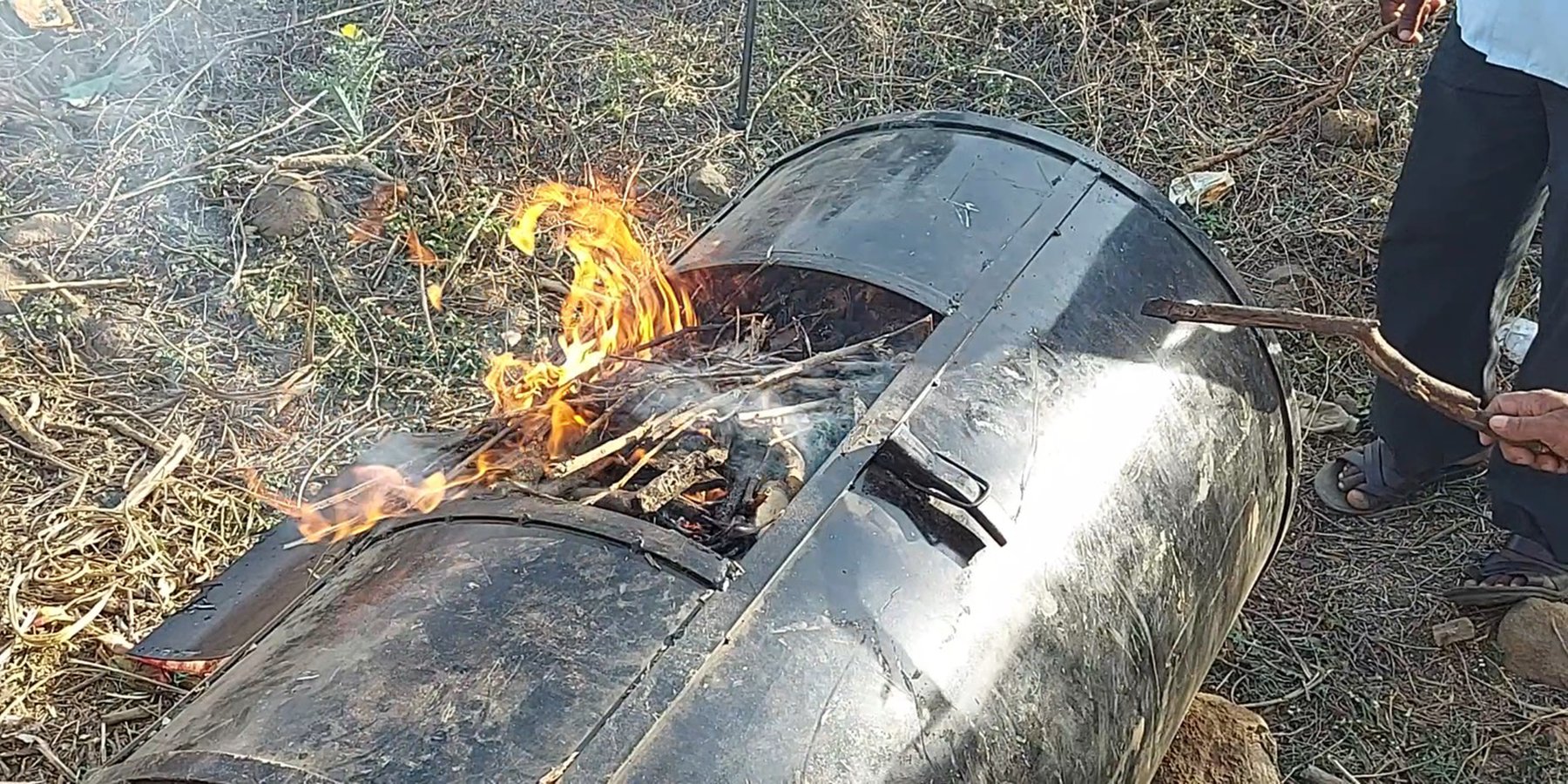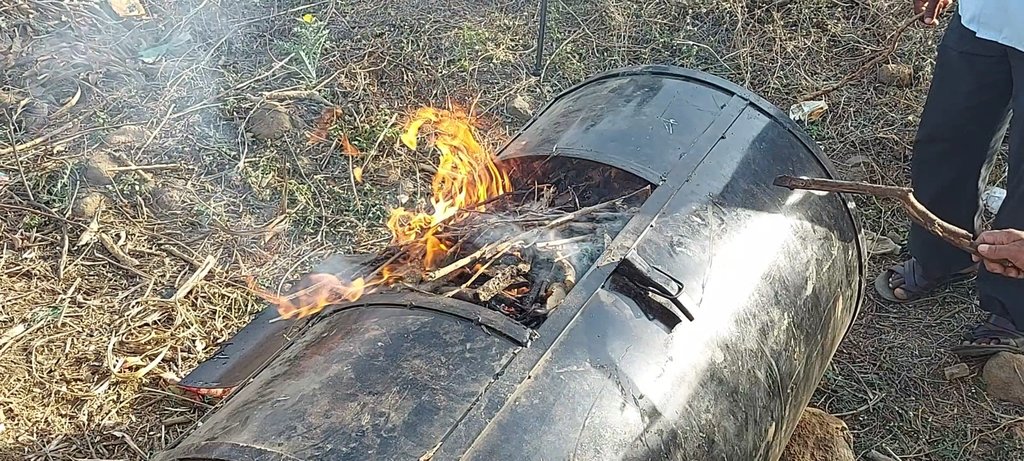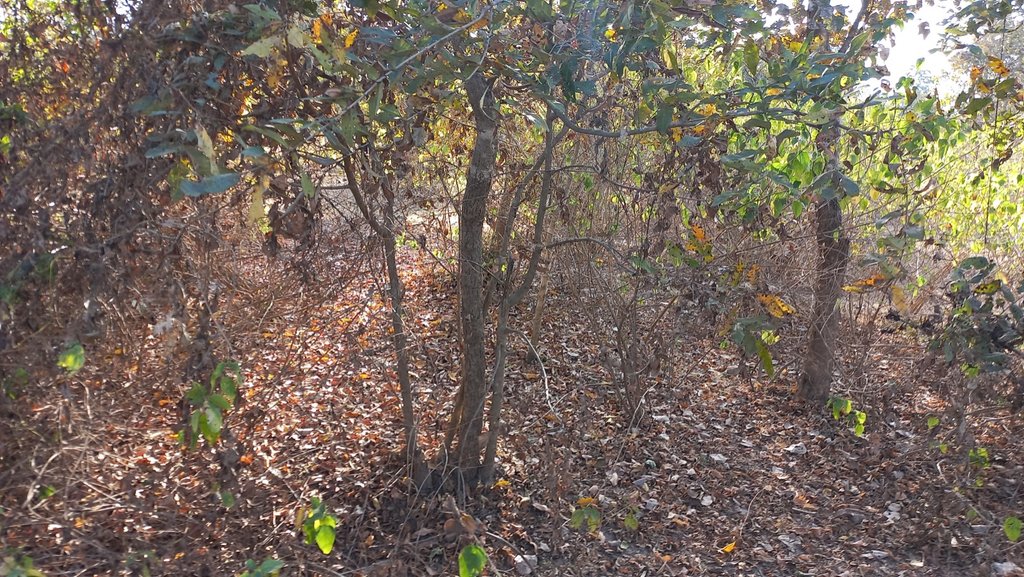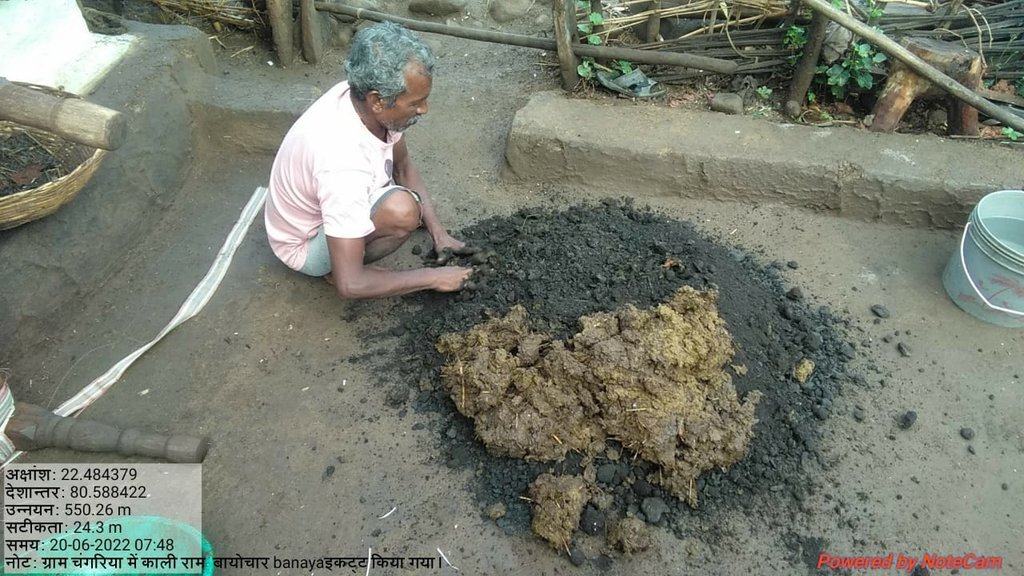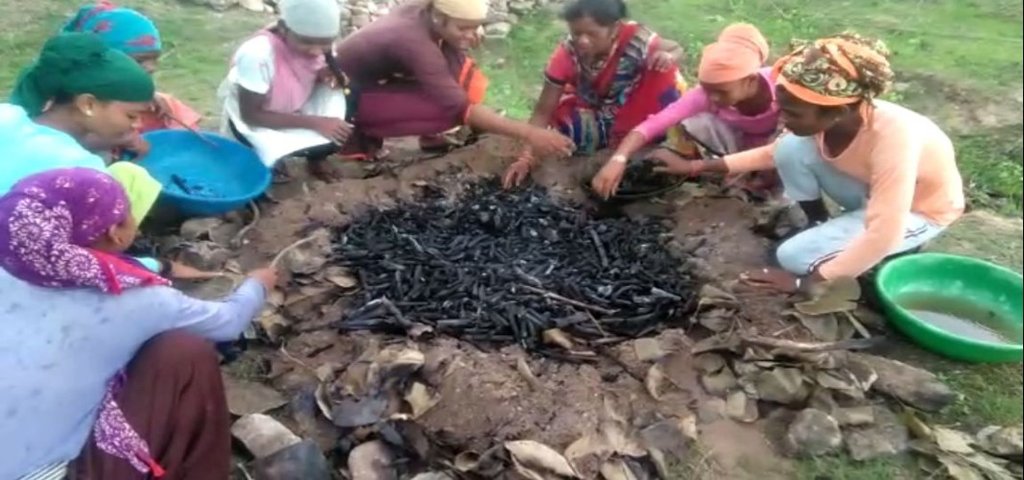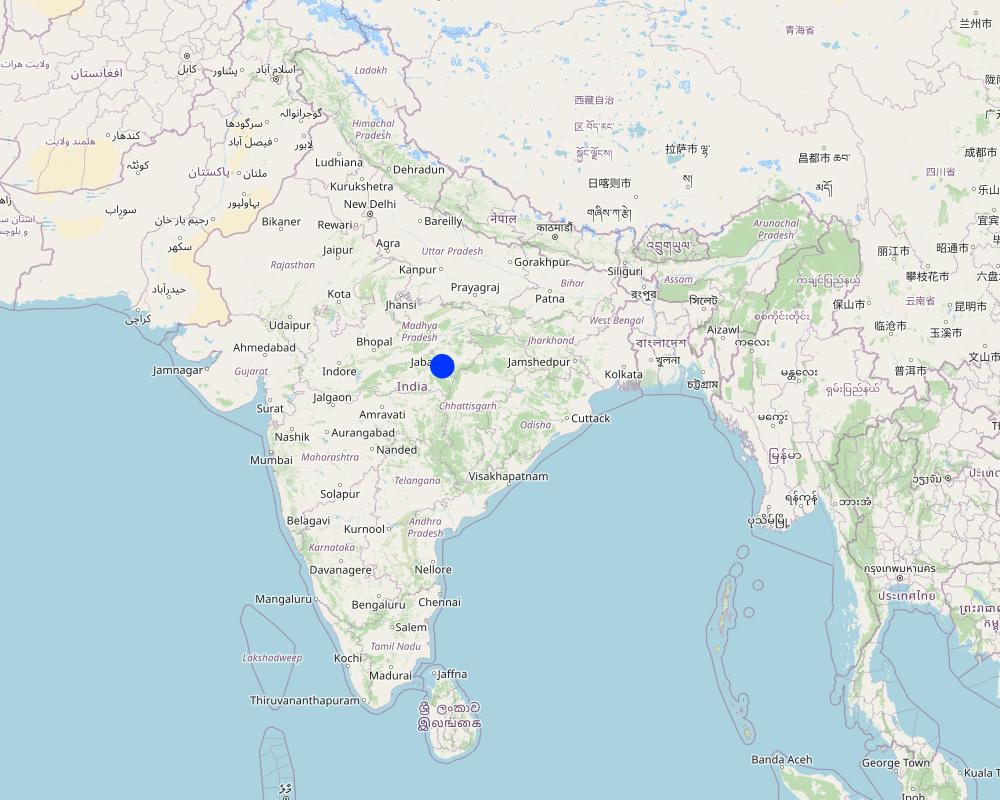Biochar Production from the Invasive Species Lantana Camara [Inde]
- Création :
- Mise à jour :
- Compilateur : Santosh Gupta
- Rédacteurs : Noel Templer, Stephanie Katsir, Kim Arora
- Examinateurs : Udo Höggel, Joana Eichenberger
technologies_6690 - Inde
Voir les sections
Développer tout Réduire tout1. Informations générales
1.2 Coordonnées des personnes-ressources et des institutions impliquées dans l'évaluation et la documentation de la Technologie
Nom du projet qui a facilité la documentation/ l'évaluation de la Technologie (si pertinent)
Soil protection and rehabilitation for food security (ProSo(i)l)Nom du ou des institutions qui ont facilité la documentation/ l'évaluation de la Technologie (si pertinent)
Deutsche Gesellschaft für Internationale Zusammenarbeit (GIZ) GmbH (GIZ) - AllemagneNom du ou des institutions qui ont facilité la documentation/ l'évaluation de la Technologie (si pertinent)
Alliance Bioversity and International Center for Tropical Agriculture (Alliance Bioversity-CIAT) - KenyaNom du ou des institutions qui ont facilité la documentation/ l'évaluation de la Technologie (si pertinent)
Ecociate Consultants (Ecociate Consultants) - Inde1.3 Conditions relatives à l'utilisation par WOCAT des données documentées
Le compilateur et la(les) personne(s) ressource(s) acceptent les conditions relatives à l'utilisation par WOCAT des données documentées:
Oui
1.4 Déclaration sur la durabilité de la Technologie décrite
Est-ce que la Technologie décrite ici pose problème par rapport à la dégradation des terres, de telle sorte qu'elle ne peut pas être déclarée comme étant une technologie de gestion durable des terres?
Non
Commentaires:
The technology discusses one of the sustainable land management practices that rehabilitate soil health by eradicating invasive species of Lantana Camara and using it to prepare biochar.
2. Description de la Technologie de GDT
2.1 Courte description de la Technologie
Définition de la Technologie:
Lantana Camara, an invasive species in India, negatively impacts biodiversity and agriculture. Biochar made from its biomass can help manage the species effectively. Traditionally farmers produce biochar in soil pit kilns. Another low-cost portable kiln unit of biochar preparation is a viable option for rainfed areas, designed to work on the direct up-draft principle with bottom ignition and circular vents for uniform heat transfer.
2.2 Description détaillée de la Technologie
Description:
Lantana Camara was introduced into India as an ornamental plant in 1809 by the British in Calcutta Botanical Garden. Lantana Camara negatively impacts biodiversity and native biota, disrupting the succession cycle, altering the structure and floral composition of native communities, and causing problems in agricultural lands in various regions of India. Its dense thickets outcompete native pastures, block the movement of grazers, and can cause poisoning. Its allelopathic activities also affect the growth of other species in its proximity. One of the measures to manage invasive species is by turning it into biochar.
Biochar is the charred biomass produced by slow pyrolysis in which organic material is heated under controlled temperatures (300-500°C) without oxygen. Lantana Camara is an ideal biomass for biochar production due to its high diversity and wide distribution. In addition to protecting ecosystems, invasive plant-derived biochar has potential applications in environmental remediation and soil amendment due to its unique structure, composition, and adsorption properties.
In the Mandla district of Madhya Pradesh, low-cost technologies for producing biochar are being practised. A low-cost portable kiln unit has been used in the Mandla District to cater to the needs of small and marginal farmers. One unit costs approximately Rs. 7000-12000 depending upon the design and location, including a metal drum, vent-making charges, and side fittings. The kiln is designed to work on the direct up-draft principle with bottom ignition. It is a vertical, single-barrel structure with a perforated base. The kiln has a square-shaped loading hole at the top, which can be closed at the end of conversion with a metal lid with a handle. The kiln has circular vents, a staggered arrangement to avoid rows, and a central vent to hold a wooden pole. Under open atmospheric conditions, the vents at the kiln base hasten hot gas movement through the bio-residues for uniform heat transfer by primary air movement. The kiln's top hole vents the released water vapours and hot gases. A strip of metal is welded around at 3/4th height of the kiln, to which two metal rods are welded on opposite sides to serve as lifting jacks. Dry Lantana Camara feedstock is placed inside the kiln unit, and a fire is lit at the bottom. Through a pyrolysis process, the organic compounds present in the biomass decompose at a specific temperature in an oxygen-limited environment.
Prior to use, the stalks/twigs of lantana are manually cut into appropriate pieces 15-19 cm long and 0.9-1.0 cm in diameter using a commonly used axe in order to achieve better packing density. Dry residues are a prerequisite to hasten satisfactory and quicker conversion. The dried residues of lantana are placed in the unit and are burned from the bottom in an oxygen-limited environment. Generally, the burning process takes 6-8 hours through a slow pyrolysis process. Once complete, the kiln is quenched with soil and left to cool for 3-4 hours. This simple and affordable biochar production method can help manage invasive plant species and benefit agriculture, the environment, and energy. The conversion ratio from biomass to biochar in the case of Lantana is around 20-25%. Farmers have reported of burning around 100 kg of dried Lantana biomass to get ~20 kg of biochar in one operation of the unit. The application rate of biochar varies from crop to crop and the type of soil and other characters. In studied project farmers do apply 20 kg of biochar mixed with 20 kg of cow dung and 20 kg of cow urine in an area of around 1 acre.
The burned biomass of Lantana after the process looks like the coal sticks, these sticks are pulverised through a pulveriser to make a powdered material for application in the field. The biochar is mixed with an equal quantity of cow dung and cow urine before the application. Some farmers also mix the native soils in biochar to get better results.
2.3 Photos de la Technologie
2.4 Vidéos de la Technologie
Commentaire, brève description:
YouTube video accessible at https://youtu.be/MPj4_I5BFRE
2.5 Pays/ région/ lieux où la Technologie a été appliquée et qui sont couverts par cette évaluation
Pays:
Inde
Région/ Etat/ Province:
Madhya Pradesh
Autres spécifications du lieu:
Mandla
Spécifiez la diffusion de la Technologie:
- appliquée en des points spécifiques ou concentrée sur une petite surface
Est-ce que les sites dans lesquels la Technologie est appliquée sont situés dans des zones protégées en permanence?
Non
Commentaires:
Farmers from the Mandla District of Madhya Pradesh State in India use the cost-effective technology of biochar preparation from Lantana Camara.
Map
×2.6 Date de mise en œuvre de la Technologie
Indiquez l'année de mise en œuvre:
2020
2.7 Introduction de la Technologie
Spécifiez comment la Technologie a été introduite: :
- au cours d'expérimentations / de recherches
- par le biais de projets/ d'interventions extérieures
Commentaires (type de projet, etc.) :
FES has worked effectively with the community to eradicate Lantana Camera from private and common land and use it for the preparation of biochar
3. Classification de la Technologie de GDT
3.1 Principal(aux) objectif(s) de la Technologie
- améliorer la production
- réduire, prévenir, restaurer les terres dégradées
- préserver l'écosystème
- conserver/ améliorer la biodiversité
- créer un impact économique positif
3.2 Type(s) actuel(s) d'utilisation des terres, là où la Technologie est appliquée
Les divers types d'utilisation des terres au sein du même unité de terrain: :
Oui
Précisez l'utilisation mixte des terres (cultures/ pâturages/ arbres):
- Agroforesterie

Terres cultivées
- Cultures annuelles
Cultures annuelles - Précisez les cultures:
- céréales - mil
- légumes - autres
- Fallow - maize/sorghum/millet
Nombre de période de croissance par an: :
- 2
Est-ce que les cultures intercalaires sont pratiquées?
Oui
Si oui, précisez quelles cultures sont produites en culture intercalaire:
Millets, Mustard, Mixed Vegetables, Maize
Est-ce que la rotation des cultures est appliquée?
Oui
Si oui, veuillez préciser:
Maize-Mustard/Wheat

Pâturages
Pâturage extensif:
- Pastoralisme transhumant
Pâturage intensif/ production fourragère :
- Affouragement en vert/ zéro-pâturage
Type d'animal:
- buffles
- bétail - laitier
- caprine
Est-ce que la gestion intégrée cultures-élevage est pratiquée?
Non

Forêts/ bois
- Forêts (semi-)naturelles/ bois
Forêts (semi-)naturelles/ terres boisées: précisez le mode de gestion:
- Enlèvement du bois mort/ bois de taille
- Utilisation de la forêt non liée au bois
Est-ce que les espèces d’arbres précisées ci-dessus sont des espèces d'arbre arbres à feuilles caduques ou à feuilles persistantes ?
- forêt mixte décidue/ à feuillage persistant
Produits et services:
- Bois d'œuvre (de construction)
- Bois de chauffage
- Fruits et noix
- Autres produits forestiers
- Pâturage/ broutage
- Conservation/ protection de la nature
Commentaires:
Lantana camara is a highly invasive plant species that can quickly spread and take over private and common land. The plant can spread rapidly by seeds or vegetative propagation, and it can grow in various environments. This makes it difficult to control once it has established itself in an area. Lantana Camara outcompetes native plant species, reduces biodiversity and alters ecosystem processes. Additionally, the plant can be toxic to livestock and wildlife, and its dense growth can increase the wildfire risk.
3.3 Est-ce que l’utilisation des terres a changé en raison de la mise en œuvre de la Technologie ?
Est-ce que l’utilisation des terres a changé en raison de la mise en œuvre de la Technologie ?
- Non (Passez à la question 3.4)

Autre
Précisez:
Removal of Lantana and making use of its biomass for preparation of biochar
Remarques:
In the case of Lantana Camara, making biochar from the plant material can help to prevent the spread of the invasive species while also producing a helpful product. Biochar has many potential uses, including as a soil amendment, a carbon sequestration tool, and a renewable energy source.
3.4 Approvisionnement en eau
Approvisionnement en eau des terres sur lesquelles est appliquée la Technologie:
- pluvial
Commentaires:
Approximately 9% of the net area sown has some source of irrigation, rest is rainfed (Source, CGWB, 2013). Significantly used sources of irrigation are canals, dug well, and tanks/ponds.
3.5 Groupe de GDT auquel appartient la Technologie
- gestion des forêts naturelles et semi-naturelles
- agroforesterie
- Amélioration de la couverture végétale/ du sol
3.6 Mesures de GDT constituant la Technologie

pratiques agronomiques
- A2: Matière organique/ fertilité du sol

pratiques végétales
- V4: Remplacement ou suppression des espèces étrangères envahissantes

modes de gestion
- M1: Changement du type d’utilisation des terres
- M5: Contrôle/ changement de la composition des espèces
3.7 Principaux types de dégradation des terres traités par la Technologie

dégradation physique des sols
- Ps: affaissement des sols organiques, tassement des sols
- Pu: perte de la fonction de bio-production en raison d’autres activités

dégradation biologique
- Bc: réduction de la couverture végétale
- Bh: perte d’habitats
- Bf: effets néfastes des feux
3.8 Prévention, réduction de la dégradation ou réhabilitation des terres dégradées
Spécifiez l'objectif de la Technologie au regard de la dégradation des terres:
- prévenir la dégradation des terres
- réduire la dégradation des terres
Commentaires:
The application of biochar improves soil health by improving the soil's organic carbon and enhancing the soil's water-holding capacity
4. Spécifications techniques, activités, intrants et coûts de mise en œuvre
4.1 Dessin technique de la Technologie
Spécifications techniques (associées au dessin technique):
Drawing of the biochar kiln developed by the expert agency
4.2 Informations générales sur le calcul des intrants et des coûts
Spécifiez la manière dont les coûts et les intrants ont été calculés:
- par superficie de la Technologie
autre/ monnaie nationale (précisez):
INR
Indiquez le taux de change des USD en devise locale, le cas échéant (p.ex. 1 USD = 79.9 réal brésilien): 1 USD = :
80,0
Indiquez le coût salarial moyen de la main d'œuvre par jour:
204
4.3 Activités de mise en place/ d'établissement
| Activité | Calendrier des activités (saisonnier) | |
|---|---|---|
| 1. | Pyrolysis of Biomass (Lantana camara) in Biochar kiln unit | October-November and June-July (Before the winter and monsoon cropping seasons). |
| 2. | Pulverisation of coal sticks received after the Pyrolysis process | October-November/June-July (Immediately after the Pyrolysis process ) |
Commentaires:
The availability of moisture in the soil makes the uprooting/removal of Lantana camara easy, that's the reason behind its removal in the post-monsoon season. Biochar is produced by the farmers just before the cropping seasons. Monsoon (Known as Kharif) and Winter (Known as Rabi) are the most dominant cropping seasons in India.
The establishment cost of a biochar production Kiln is low, as it is specially designed for small and marginal farmers. The unit once purchased can be used for 8-10 years with a very low maintenance cost.
4.4 Coûts et intrants nécessaires à la mise en place
| Spécifiez les intrants | Unité | Quantité | Coûts par unité | Coût total par intrant | % des coût supporté par les exploitants des terres | |
|---|---|---|---|---|---|---|
| Equipements | Biochar Kiln | Number | 1,0 | 7000,0 | 7000,0 | 25,0 |
| Equipements | Pulverizer unit | Number | 1,0 | 20000,0 | 20000,0 | 25,0 |
| Coût total de mise en place de la Technologie | 27000,0 | |||||
| Coût total de mise en place de la Technologie en dollars américains (USD) | 337,5 | |||||
Si le coût n'est pas pris en charge à 100% par l'exploitant des terres, indiquez qui a financé le coût restant:
The remaining cost is being covered by the project funds routed through community organisations
Commentaires:
The design of the biochar kiln is simple, there is hardly any cost involved in maintaining the unit. Labour cost is required generally for the removal of Lantana Camara and for the preparation of the biochar. Exact costs cannot be indicated at this time.
4.5 Activités d'entretien/ récurrentes
| Activité | Calendrier/ fréquence | |
|---|---|---|
| 1. | Preparation of Biochar | Before the sowing of Rabi and Kharif season (Month of October/November and June/July) |
| 2. | Application of Biochar in the field | During the crops seasons; |
Commentaires:
No maintainance cost is involved in preparing biochar from Lantana Camara, as the design of the kiln is straightforward and cost-effective. Preventing the regrowth of Lantana Camara in the areas where it is removed is the only monitoring factor involved at regular intervals.
4.6 Coûts et intrants nécessaires aux activités d'entretien/ récurrentes (par an)
| Spécifiez les intrants | Unité | Quantité | Coûts par unité | Coût total par intrant | % des coût supporté par les exploitants des terres | |
|---|---|---|---|---|---|---|
| Main d'œuvre | Labor cost for removal of lantana | ha | 1,0 | 5000,0 | 5000,0 | 25,0 |
| Main d'œuvre | Preparation of biochar | Person-day | 2,0 | 200,0 | 400,0 | 100,0 |
| Main d'œuvre | Application of biochar in the field | Person-day | 0,5 | 200,0 | 100,0 | 100,0 |
| Main d'œuvre | Transportation of lantana | Trip | 1,0 | 200,0 | 200,0 | 100,0 |
| Engrais et biocides | Cow dung | kg | 20,0 | 5,0 | 100,0 | 100,0 |
| Engrais et biocides | Cow urine | kg | 20,0 | 5,0 | 100,0 | 100,0 |
| Coût total d'entretien de la Technologie | 5900,0 | |||||
| Coût total d'entretien de la Technologie en dollars américains (USD) | 73,75 | |||||
Commentaires:
Recurring cost includes removing the lantana and preparing biochar, and cow dung and cow urine must be mixed with biochar before application in the field. In most cases, family members are engaged as labour.
4.7 Facteurs les plus importants affectant les coûts
Décrivez les facteurs les plus importants affectant les coûts :
Cost of the biochar kiln
5. Environnement naturel et humain
5.1 Climat
Précipitations annuelles
- < 250 mm
- 251-500 mm
- 501-750 mm
- 751-1000 mm
- 1001-1500 mm
- 1501-2000 mm
- 2001-3000 mm
- 3001-4000 mm
- > 4000 mm
Spécifiez la pluviométrie moyenne annuelle (si connue), en mm:
1427,00
Spécifications/ commentaires sur les précipitations:
Monsoon season is June-September which has the majority of the rainfall
Indiquez le nom de la station météorologique de référence considérée:
District at Glance report of Ministry of Water Resources, Central Groundwater Board, North Central Region BHOPAL, 2013
Zone agro-climatique
- subhumide
- semi-aride
The National Bureau of Soil Survey & Land Use Planning (NBSS&LUP) developed twenty agroecological zones based on the growing period as an integrated criterion of adequate rainfall and soil groups. It delineated boundaries adjusted to district boundaries with a minimal number of regions. Mandla District of Madhya Pradesh lies in a Hot subhumid ecoregion with red and black soil. The part of the district also lies in a semi-arid region as these regions don't have irrigation facilities and the length of the growing period lies between 75-179 days.
Precepitation - 1000–1500mm; Potential Evapotranspiration -1300–1500 mm; Lenght of Growing Period-150–180days
5.2 Topographie
Pentes moyennes:
- plat (0-2 %)
- faible (3-5%)
- modéré (6-10%)
- onduleux (11-15%)
- vallonné (16-30%)
- raide (31-60%)
- très raide (>60%)
Reliefs:
- plateaux/ plaines
- crêtes
- flancs/ pentes de montagne
- flancs/ pentes de colline
- piémonts/ glacis (bas de pente)
- fonds de vallée/bas-fonds
Zones altitudinales:
- 0-100 m
- 101-500 m
- 501-1000 m
- 1001-1500 m
- 1501-2000 m
- 2001-2500 m
- 2501-3000 m
- 3001-4000 m
- > 4000 m
Indiquez si la Technologie est spécifiquement appliquée dans des:
- non pertinent
Commentaires et précisions supplémentaires sur la topographie:
The project area is hilly and forested (Satpura hill range) and highly undulating with narrow strips of cultivated plains in the valley portion of the river. The plateau is in the northern part, formed by basalt and east-west trending hill in the southern region. The highest elevation is 934 m amsl in the northern part, and the lowest elevation is around 400 m amsl in the northwestern part of the area. Protected forest areas cover a large majority of the site in the district as part of the Kanha National Park.
5.3 Sols
Profondeur moyenne du sol:
- très superficiel (0-20 cm)
- superficiel (21-50 cm)
- modérément profond (51-80 cm)
- profond (81-120 cm)
- très profond (>120 cm)
Texture du sol (de la couche arable):
- grossier/ léger (sablonneux)
- moyen (limoneux)
Texture du sol (> 20 cm sous la surface):
- moyen (limoneux)
- fin/ lourd (argile)
Matière organique de la couche arable:
- faible (<1%)
Si disponible, joignez une description complète du sol ou précisez les informations disponibles, par ex., type de sol, pH/ acidité du sol, capacité d'échange cationique, azote, salinité, etc.
Soil Testing Parameter status (Average) 2017-20 for the project areas is as follows. This data is based on the soil samples tested by the FES in its soil labs from the project villages.
Soil pH:- 5.906548628; EC (electrical conductivity):- 0.122993577; Soil Organic Carbon:- 0.83%; Nitrogen. :- 293.3696598; Phosphorus:- 25.77762582; Potassium (K):- 139.6696636; Sulphur (S):-18.93457993; Zinc (Zn):- 0.955246706; Boron (Bn):- 0.490850376
5.4 Disponibilité et qualité de l'eau
Profondeur estimée de l’eau dans le sol:
5-50 m
Disponibilité de l’eau de surface:
moyenne
Qualité de l’eau (non traitée):
faiblement potable (traitement nécessaire)
La qualité de l'eau fait référence à:
à la fois les eaux souterraines et de surface
La salinité de l'eau est-elle un problème? :
Non
La zone est-elle inondée?
Non
Commentaires et précisions supplémentaires sur la qualité et la quantité d'eau:
The groundwater status is within the safe limits as per the reports by the Government of Madhya Pradesh. People use water from rivers, streams, and traditional small wells for domestic purposes. In the absence of good vegetative cover, the rainwater washes off the fertile topsoil from the farmlands making the land barren and resulting in the siltation of ponds and other water bodies. Further, a heavy infestation of invasive species such as Lantana Camara compounds the degradation.
The studied block Bichhiya is in a better position in terms of stage of groundwater development with 17%, while the average of the district is 7%. The stage of groundwater development refers to the % of groundwater being used for various purposes from the available groundwater in that area e.g. net annual groundwater availability in Bichhiya block is 9087 ham (hectare meters) while the existing annual ground water draft for all usage is 1523 ham, making it a 17% groundwater development stage.
Source: http://cgwb.gov.in/District_Profile/MP/Mandla.pdf
5.5 Biodiversité
Diversité des espèces:
- élevé
Diversité des habitats:
- élevé
Commentaires et précisions supplémentaires sur la biodiversité:
The area is surrounded by Kanha National Park and Phen Wildlife Sanctuary, with a good presence of forest area. World famous Kanha Tiger Reserve is situated in the Mandla district. Kanha is famous for Tiger and Barasingha. Kanha has numerous species of insects, butterflies, reptiles, fishes, and other lesser life forms. Important mammals, birds, reptiles, crustaceans, amphibians, insects, mollusks, and fishes are found in Kanha National Park. The faunal diversity of the district represents 32 wild animals, 63 birds, 4 fishes, and 9 reptile species, respectively. Regarding floral diversity, out of 1006 plant species available in the district, 162 are tree species, followed by 71 species of shrubs, 681 species of herbs, 51 species of climbers, 39 species of grasses, and 2 species of parasites. Mandla is richer in herbaceous species than other adjoining districts like Jabalpur and Seoni.
Source:- Documentation of Biodiversity Status in Mandla District of Madhya Pradesh https://mpsbb.mp.gov.in/completedProject/MB.pdf
5.6 Caractéristiques des exploitants des terres appliquant la Technologie
Sédentaire ou nomade:
- Sédentaire
Orientation du système de production:
- exploitation mixte (de subsistance/ commerciale)
Revenus hors exploitation:
- > 50% de tous les revenus
Niveau relatif de richesse:
- pauvre
- moyen
Individus ou groupes:
- individu/ ménage
- groupe/ communauté
Niveau de mécanisation:
- travail manuel
- traction animale
Genre:
- femmes
- hommes
Age des exploitants des terres:
- jeunes
- personnes d'âge moyen
Indiquez toute autre caractéristique pertinente des exploitants des terres:
The large majority of the user belong to the tribal community, including some households from an ethnic community called Baiga.
https://en.wikipedia.org/wiki/Baiga_tribe
5.7 Superficie moyenne des terres utilisées par les exploitants des terres appliquant la Technologie
- < 0,5 ha
- 0,5-1 ha
- 1-2 ha
- 2-5 ha
- 5-15 ha
- 15-50 ha
- 50-100 ha
- 100-500 ha
- 500-1 000 ha
- 1 000-10 000 ha
- > 10 000 ha
Cette superficie est-elle considérée comme de petite, moyenne ou grande dimension (en se référant au contexte local)?
- petite dimension
5.8 Propriété foncière, droits d’utilisation des terres et de l'eau
Propriété foncière:
- communauté/ village
- individu, avec titre de propriété
Droits d’utilisation des terres:
- individuel
Droits d’utilisation de l’eau:
- communautaire (organisé)
- individuel
Est-ce que les droits d'utilisation des terres sont fondés sur un système juridique traditionnel?
Oui
Précisez:
The concerned authorities have issued landowners the land certificates.
5.9 Accès aux services et aux infrastructures
santé:
- pauvre
- modéré
- bonne
éducation:
- pauvre
- modéré
- bonne
assistance technique:
- pauvre
- modéré
- bonne
emploi (par ex. hors exploitation):
- pauvre
- modéré
- bonne
marchés:
- pauvre
- modéré
- bonne
énergie:
- pauvre
- modéré
- bonne
routes et transports:
- pauvre
- modéré
- bonne
eau potable et assainissement:
- pauvre
- modéré
- bonne
services financiers:
- pauvre
- modéré
- bonne
6. Impacts et conclusions
6.1 Impacts sur site que la Technologie a montrés
Impacts socio-économiques
Production
production agricole
Commentaires/ spécifiez:
Approximately increase of 15-20% across the crops. Where biochar was used, since this has happened in multiple commodities specifying the number for any crop will not do justice.
qualité des cultures
Commentaires/ spécifiez:
Grain size, the strength of biomass and overall taste of the grains. These are the qualitative measures which can not be addressed in numbers.
gestion des terres
Disponibilité et qualité de l'eau
disponibilité de l'eau d'irrigation
Commentaires/ spécifiez:
Biochar maintains soil moisture thus, farmers need to use less quantity of water for irrigation.
Impacts socioculturels
connaissances sur la GDT/ dégradation des terres
Impacts écologiques
Biodiversité: végétale, animale
Couverture végétale
Commentaires/ spécifiez:
Lantana Camara negatively impacts biodiversity and native biota. Its dense thickets outcompete native pastures, blocks the movement of grazers, and can cause poisoning. Its eradication helps improving the vegetative cover.
diversité végétale
Commentaires/ spécifiez:
As the density of Lantana Camara in the forest increases, allelopathic interactions increase, and hence, species richness declines (Day et al., 2003).
espèces étrangères envahissantes
Commentaires/ spécifiez:
The invasive alien species of Lantana Camara are removed from private and common land.
diversité animale
diversité des habitats
Réduction des risques de catastrophe et des risques climatiques
risques d'incendies
6.2 Impacts hors site que la Technologie a montrés
disponibilité de l'eau
6.4 Analyse coûts-bénéfices
Quels sont les bénéfices comparativement aux coûts de mise en place (du point de vue des exploitants des terres)?
Rentabilité à court terme:
positive
Rentabilité à long terme:
très positive
Quels sont les bénéfices comparativement aux coûts d'entretien récurrents (du point de vue des exploitants des terres)?
Rentabilité à court terme:
légèrement positive
Rentabilité à long terme:
très positive
Commentaires:
The cost of biochar production is almost negligible for farmers as it is made using local resources, while the benefits are multifold in terms of crop production, quality, and soil health improvement.
6.5 Adoption de la Technologie
- 1-10%
De tous ceux qui ont adopté la Technologie, combien d'entre eux l'ont fait spontanément, à savoir sans recevoir aucune incitation matérielle, ou aucune rémunération? :
- 0-10%
Commentaires:
A number of farmers adopted the technology without any financial support from the project
6.6 Adaptation
La Technologie a-t-elle été récemment modifiée pour s'adapter à l'évolution des conditions?
Oui
autre (précisez):
Technology
Spécifiez l'adaptation de la Technologie (conception, matériaux/ espèces, etc.):
Several farmers adopted biochar production using a traditional method of digging a pit and preparing the biochar.
6.7 Points forts/ avantages/ possibilités de la Technologie
| Points forts/ avantages/ possibilités du point de vue de l'exploitant des terres |
|---|
| Communities have found biochar as an essential input to meet the nutrient requirement of their soil. They have improved the quality of their farm produce by applying biochar. |
| Preparation of Biochar using Lantana Camara has emerged as an excellent use for the invasive species, which otherwise was not having any use and was growing like fire in the area |
| Improved production of the farm produce |
| Points forts/ avantages/ possibilités du point de vue du compilateur ou d'une autre personne ressource clé |
|---|
| Biochar is an excellent input for improving soil organic carbon. It can lead to healthy soil with an improved capacity of the soil to sequester carbon. |
| Over the years, soils have degraded to a great extent in the project geography. Biochar can reverse this process. |
| Farmers can grow short-duration crops and fodder for their animals in a rainfed area, with improved soil moisture. This will help improve farmers' income. |
6.8 Faiblesses/ inconvénients/ risques de la Technologie et moyens de les surmonter
| Faiblesses/ inconvénients/ risques du point de vue de l’exploitant des terres | Comment peuvent-ils être surmontés? |
|---|---|
| The capacity of existing biochar kiln units is limited, and farmers have to wait for their turn | More units can be mobilized with community-based engagement and support from externally funded projects |
| Hard work and a long process involved uprooting lantana, drying, transportation, burning, and application | Communities need handholding and training about its importance and more technological advances |
| Faiblesses/ inconvénients/ risques du point de vue du compilateur ou d'une autre personne ressource clé | Comment peuvent-ils être surmontés? |
|---|---|
| In the long run, the easy accessibility of Lantana may be a concern if it is implemented on a large scale. The availability of other biomass is very much limited. | An assessment of the availability of Lantana and its annual requirement for biochar preparation can be done |
| Biochar has long-term benefits, while communities look for short-term solutions | Handholding the communities along with linking them with carbon credit-related projects may be a good option to keep farmers motivated |
| Regular application of biochar over the years | Regular communication with farmers about the positive outcome aligned with other financial incentives linked to soil organic carbon improvement |
7. Références et liens
7.1 Méthodes/ sources d'information
- visites de terrain, enquêtes sur le terrain
1
- interviews/entretiens avec les exploitants des terres
10
- compilation à partir de rapports et d'autres documents existants
3
Quand les données ont-elles été compilées (sur le terrain)?
22/02/2023
Commentaires:
During the field visit, detailed discussions were held with the project implementing agency, communities, and other stakeholders to understand the process and impact of the intervention.
7.2 Références des publications disponibles
Titre, auteur, année, ISBN:
Invasive plants as potential sustainable feedstocks for biochar production and multiple applications: A review, Qianwei Feng a, Bing Wang a b c, Miao Chen a b c, Pan Wu a b c, Xinqing Lee d, Ying Xing e
Disponible à partir d'où? Coût?
https://doi.org/10.1016/j.resconrec.2020.105204
Titre, auteur, année, ISBN:
Biochar for Soil Health Enhancement and Crop Productivity Improvement, Awtar Singh1*, A.P. Singh2, V. Singh1, Arijit Barman1, Sagar Vibhute1 and R.S. Tolia
Disponible à partir d'où? Coût?
Innovative Farming, 1(4): 137-140, 2016
Titre, auteur, année, ISBN:
A review of Lantana camara studies in India, Neena Priyanka*,**, P. K. Joshi*
Disponible à partir d'où? Coût?
International Journal of Scientific and Research Publications, Volume 3, Issue 10, October 2013 ISSN 2250-3153
Titre, auteur, année, ISBN:
Annual Progress Report on Promotion of Biochar in Mandla, developed by FES for the year 2021-22
Disponible à partir d'où? Coût?
Internal document of FES, shared as part of the project report to GIZ. This document can be obtained from the GIZ office, India
7.3 Liens vers les informations pertinentes en ligne
Titre/ description:
District at a glance by Central Ground Water Board
URL:
http://cgwb.gov.in/District_Profile/MP/Mandla.pdf
Titre/ description:
Low cost Kiln for Biochar Production
URL:
http://www.nicra-icar.in/nicrarevised/images/Home/NICRA%20Technical%20Brochure%20Portable%20Kiln.pdf
Titre/ description:
Baiga Tribes
URL:
https://en.wikipedia.org/wiki/Baiga_tribe
Titre/ description:
Biochar on soil properties and crop performance
URL:
https://www.indiascienceandtechnology.gov.in/research/biochar-soil-properties-and-crop-performance
Titre/ description:
Video by FES on Biochar production (Hindi)
URL:
https://www.youtube.com/watch?v=MPj4_I5BFRE
Titre/ description:
A review of Lantana camara studies in India
URL:
https://www.ijsrp.org/research-paper-1013/ijsrp-p2207.pdf
Titre/ description:
Low Cost Portable Kiln for Biochar Production
URL:
http://www.nicra-icar.in/nicrarevised/images/Home/NICRA%20Technical%20Brochure%20Portable%20Kiln.pdf
Liens et modules
Développer tout Réduire toutLiens
Aucun lien
Modules
Aucun module trouvé


